Competencies on the Map
Introduction
Our consideration of organizational competencies is not simply background information, we can actively add it to our strategy and consider it in our Cognitive Map for the offering.
Although this discussion of organizational competencies may appear to happen rather late in the innovation process, it is by no means an afterthought or to be given short consideration. There are a few, very purposeful reasons why we choose to hold what is an examination of organizational strengths and weaknesses:
- It tends to constrain–not open–our views. If we identify twenty potentially interesting strategies early in the process, and then begin to cull them based on what the organization's competencies are, we may be inadvertently short-circuiting the innovation process by bringing constraints into the process too early. If our goal is to innovate in the sustainability space, we should consider each potential strategy by its own merits before we begin trimming and prioritizing.
- It leans toward the tactical and executional, instead of the strategic. Layering constraints and practicalities also tends to draw one into the execution of an idea or offering, as opposed to the strategy or ideation of the same.
- It represents feasibility for the organization at a point in time. This is especially important because if an opportunity is significant enough, the organization will likely stretch to expand its competencies. So, when considering competencies at a given point in time, it neglects the ability for the organization to grow and adapt around opportunity.
- It does not represent the competencies of external partners. In all of this discussion, we are considering the organization internally. While this represents the core of how the innovation offering will be created, it also does not account for the essentially unlimited scope of competencies an organization can subcontract or add. If an organization is weak in marketing, it finds an ad agency or marketing consultancy; if an organization is weak in fulfillment, it finds a logistics firm.
So, as we begin to go through the rigor of layering the organization's competencies onto our Map, do not consider a gap in competencies to be a reason not to pursue a strategy, but a signal that additional competencies will need to be added for the offering to be successful.
In the following, we will consider some organizational scenarios, examine how they may influence our interpretations of the Map, and what they may signal for those involved. Remember there are many different strategies and tactics which we can use, and the below are sample narratives that an organization could consider.
Scenario #1: The Marketing Powerhouse
In this case, both the rewards and barriers are potentially high. If an organization sought to tap what is a new constellation of concepts centered around "Can enjoy surroundings, weather," "More time for family/kids," and "I am a good dad/mom," it would have to be acknowledged that there would be a heavy marketing/storytelling need to gain traction. While any organization could take the rogue position and attempt to own this space in the minds of customers, we could consider this strategy may be best served by those with heavy ad spend, high marketing competency, and a strong brand.
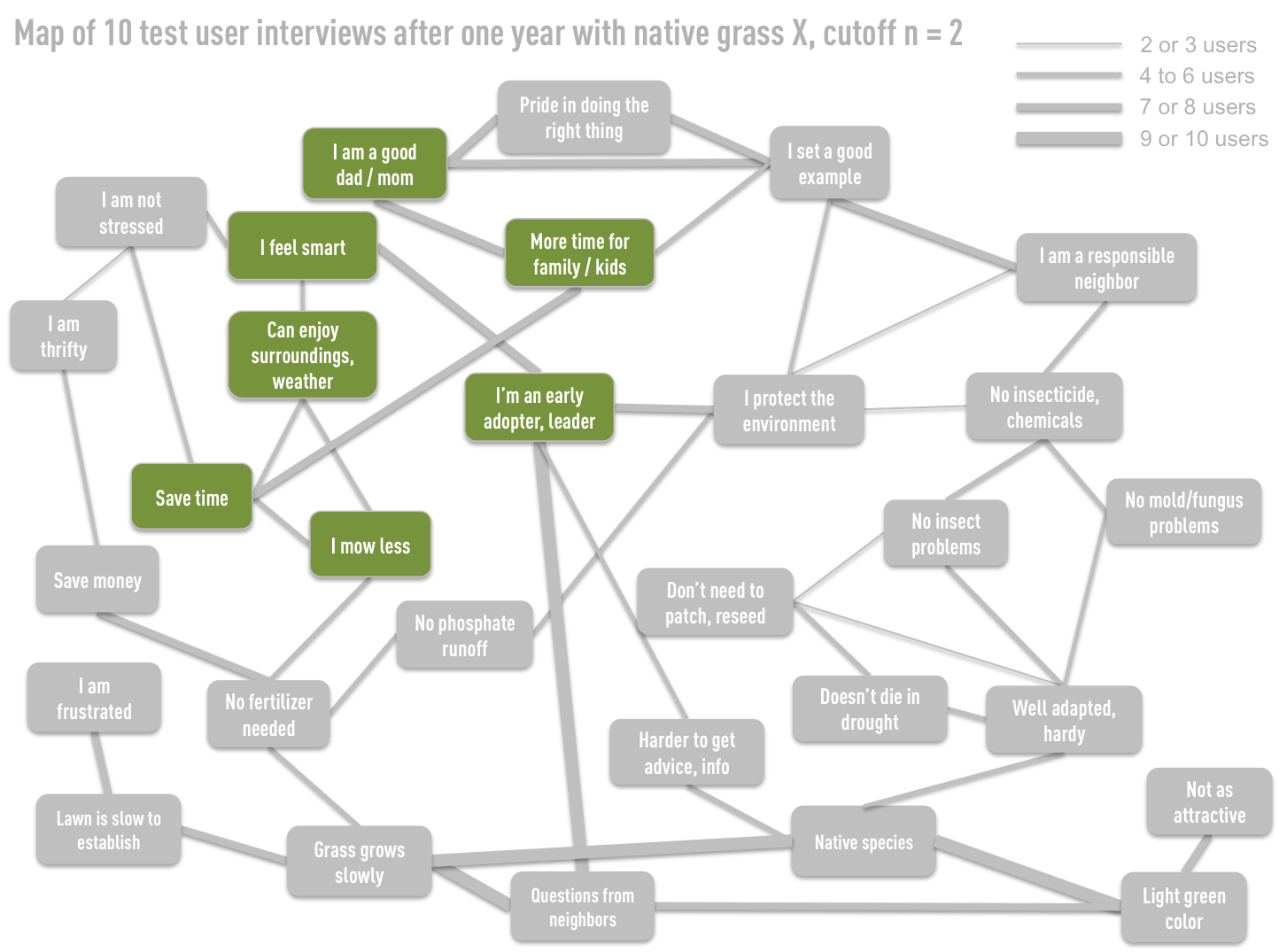
Here we see a subset of attributes from the image "Map of 10 test user interviews after one year with native grass X, cutoff n = 2."
The subset includes concepts centered around the following topics:
- Can enjoy surroundings, weather,
- More time for family/kids, and
- I am a good dad/mom
and includes the following attributes:
- I am a good dad/mom
- More time for family/kids
- I feel smart
- I'm an early adopter, leader
- Can enjoy surroundings, weather
- Save time
- I mow less
Scenario #2: The Upstart/Startup
If we are considering a potential strategy for a new, perhaps small organization, we would likely be well served by tapping existing concepts as opposed to trying to create spaces and educate the market. In this case, the story would be clear: Native grass X is easy to care for because it is well adapted, so it does not require the chemical and herbicidal inputs that the seed from the neighborhood "big box" would.
By taking this strategy in a smaller startup, we would embrace the position of a sustainable "fighter brand," taking a clearly defined position against the incumbent lawn products companies. When in startup mode, we have to consider the ability to own the message against far more well-funded companies, so the goal is to chisel out a niche and own it.
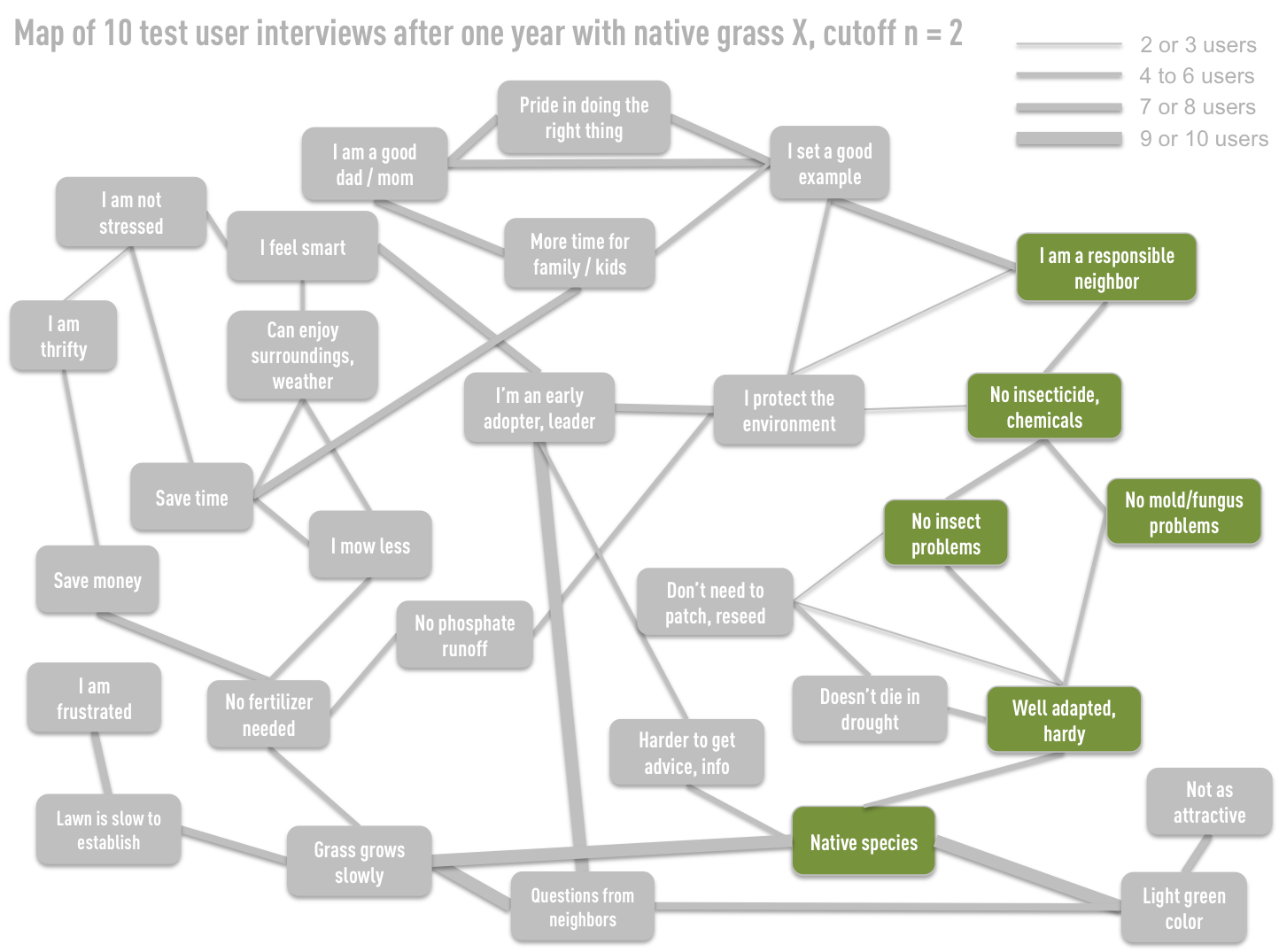
Here we see a subset of attributes from the image "Map of 10 test user interviews after one year with native grass X, cutoff n = 2."
The subset includes concepts centered around the following topics:
- Native grass X is easy to care for
- Does not require chemical and herbicidal inputs
- “Fighter brand”
and includes the following attributes:
- I am a responsible neighbor
- No insecticides/chemicals
- No mold/fungus problems
- No insect problems
- Well adapted/hardy
- Native species
Scenario #3: The Product Expert
Some organizations are especially competent on the product knowledge side, perhaps boasting especially deep technical and product knowledge. In this case, let us imagine the organization has a couple PhDs in plant biology who can represent that deep knowledge. Let's also assume this product expertise approach is one taken on the other seeds and products in the portfolio (i.e., why they have two PhDs on staff).
In this case, the strategy could embrace that knowledge and tell the story of the attributes and what makes the seed different. In this case, we could take what could be a negative attribute ("Light green color"), and own it as a badge of pride, of sorts. Our goal here could be to leverage the knowledge competency already in the organization to make our early adopter customers "experts," as well, knowing that they will be answering questions from neighbors, etc.
In this strategy, we could also elect to leverage the fact that there is indeed less information about "native grass X" as a lawn seed, and therefore it is that much more important to rely on a company with expertise and experience to help you.
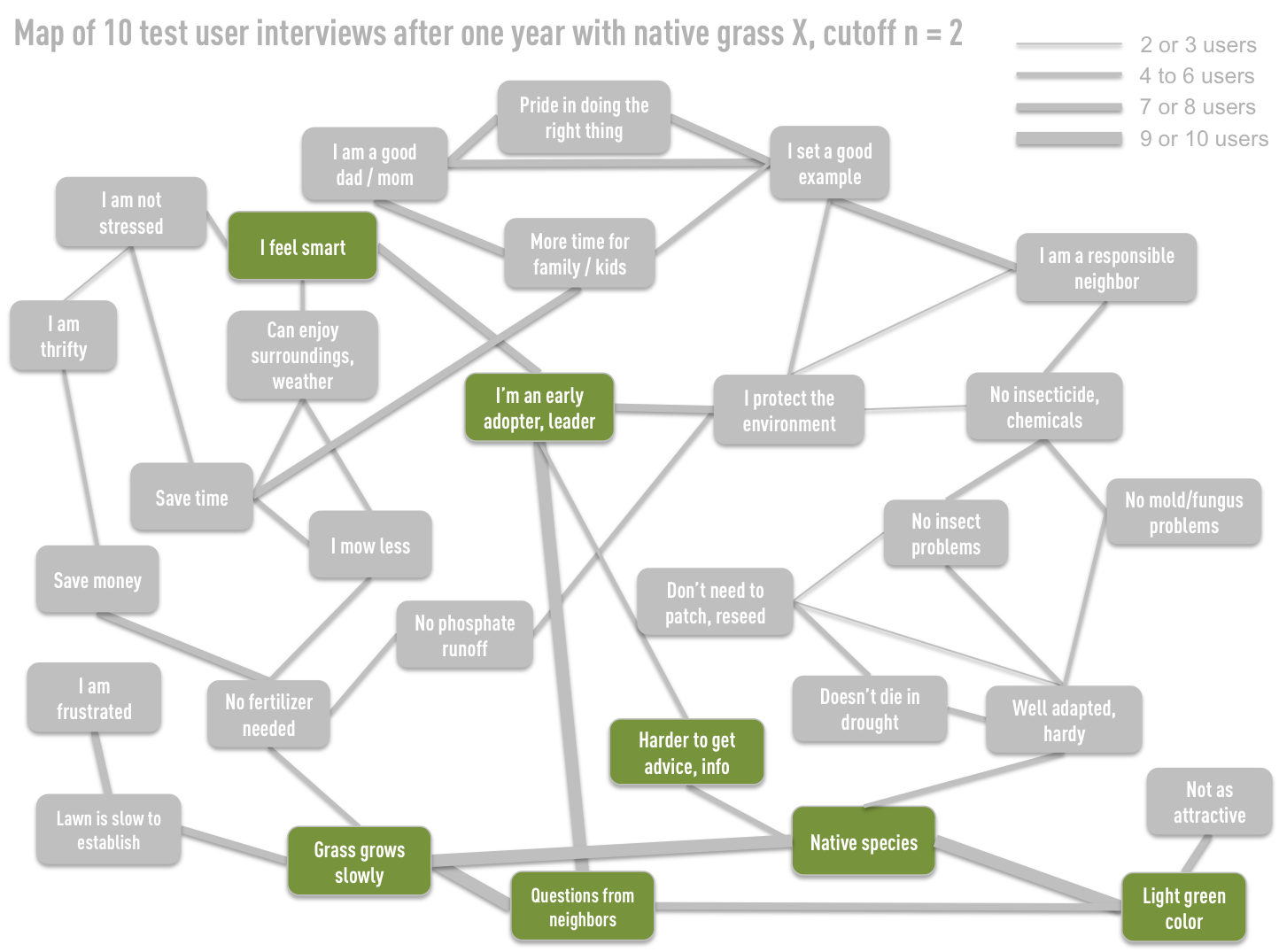
Here we see a subset of attributes from the image "Map of 10 test user interviews after one year with native grass X, cutoff n = 2."
The subset includes concepts centered around the following topics:
- Early adopter customers are "experts"
- Important to rely on a company with expertise and experience to help you
and includes the following attributes:
- I feel smart
- I’m an early adopter, leader
- Harder to get advice, info
- Native species
- Grass grows slowly
- Questions from neighbors
- Light green color
Scenario #4: The Social Leader
In the case of an organization (or non-profit) with an especially strong social pull or presence, we should elect to take a strategy which leverages this competency and reach as much as possible.
The strategy here could be a fairly pure sustainability play, one which talks about how wasteful lawns are (CHG needed to create fertilizer, water intensity, etc.), and then compares this resource intensity to that of a native grass. Similar to "droughtshaming" that happened in the midst of the California droughts, we could elect to go even further as part of "lawnshaming," while also reinforcing that a beautiful lawn can be had in a far less wasteful manner.
This strategy could also highly leverage Instagram, Twitter, and other social channels to support those converting their lawns, by showing how much less effort and material it takes to maintain, etc. It is one destined for infographics, shares, and bringing the wasteful lawn to light. 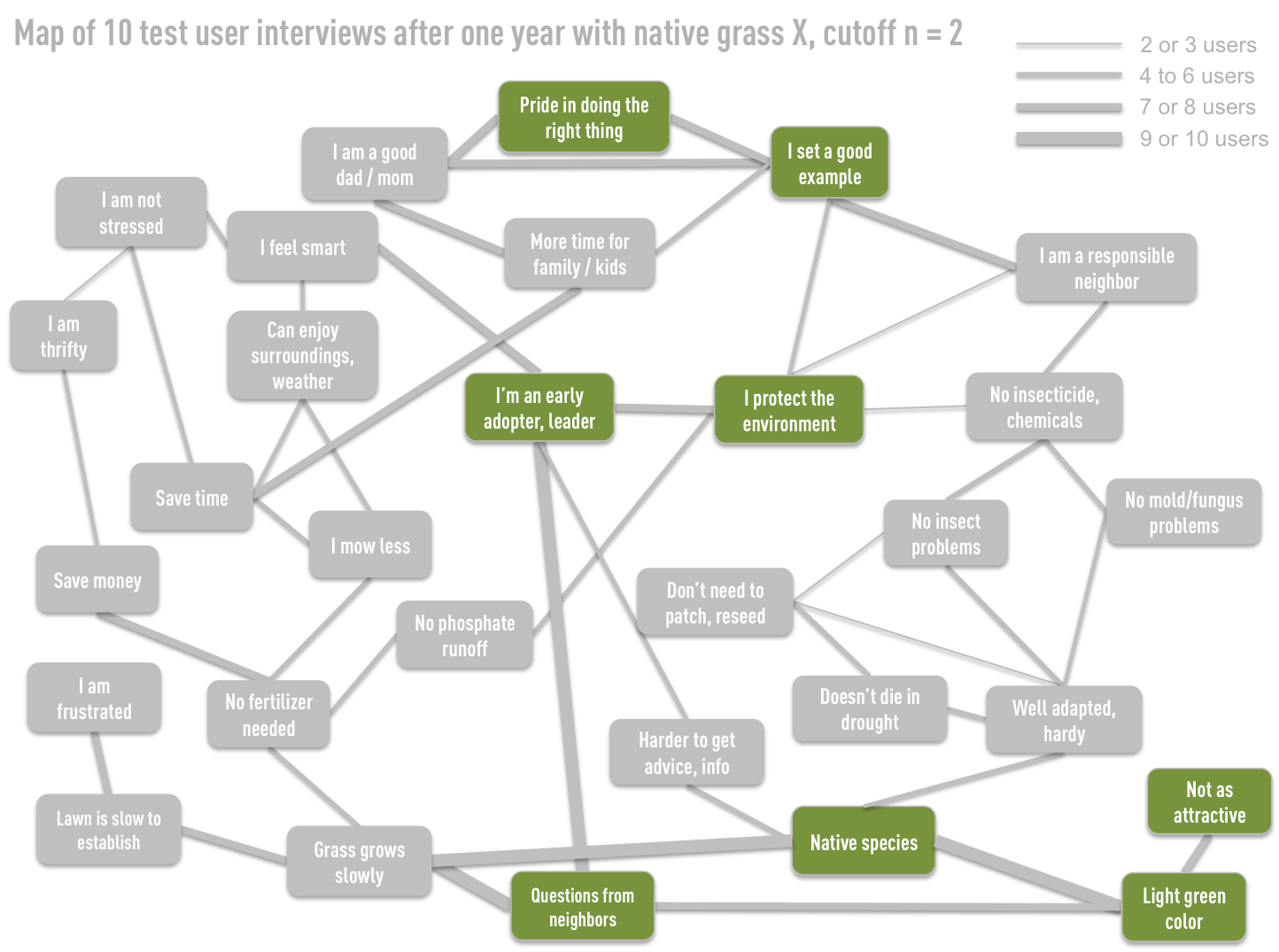
Here we see a subset of attributes from the image "Map of 10 test user interviews after one year with native grass X, cutoff n = 2."
The subset includes concepts centered around the following topics:
- Lawns are wasteful (CHG needed to create fertilizer, water intensity, etc.)
- “Lawnshaming”
- Beautiful lawns can be had in a far less wasteful manner
- How much less effort and material it takes to maintain
- Leverage Instagram, Twitter, and other social channels
and includes the following attributes:
- Pride in doing the right thing
- I set a good example
- I’m an early adopter, leader
- I protect the environment
- Native species
- Questions from neighbors
- Not as attractive
- Light green color
Scenario #5: The Lean Operation
If we are in an organization which embraces the "fast follower" approach to the product offering and gaining as much leverage as possible as quickly as possible, we may elect to pursue a strategy built around an almost accounting-based approach. This is one which could leverage a tactic such as an online calculator to calculate time and financial savings from converting an existing lawn to native seed, for example.
In its purest form, an approach a lean operation could elect to take would be to take the concept path with the highest current use/potential/traffic, and see if it can capture some percentage of revenue. This is not necessarily a strategy which is especially appealing to those most concerned with brand building, but it is one which is an obvious strategy, and one which could allow rapid growth in market share.
In essence, it is a similar bite-sized and elegant approach to strategy, just a larger niche: "Tired of mowing your lawn all the time? Mow 40% less with native grass x."
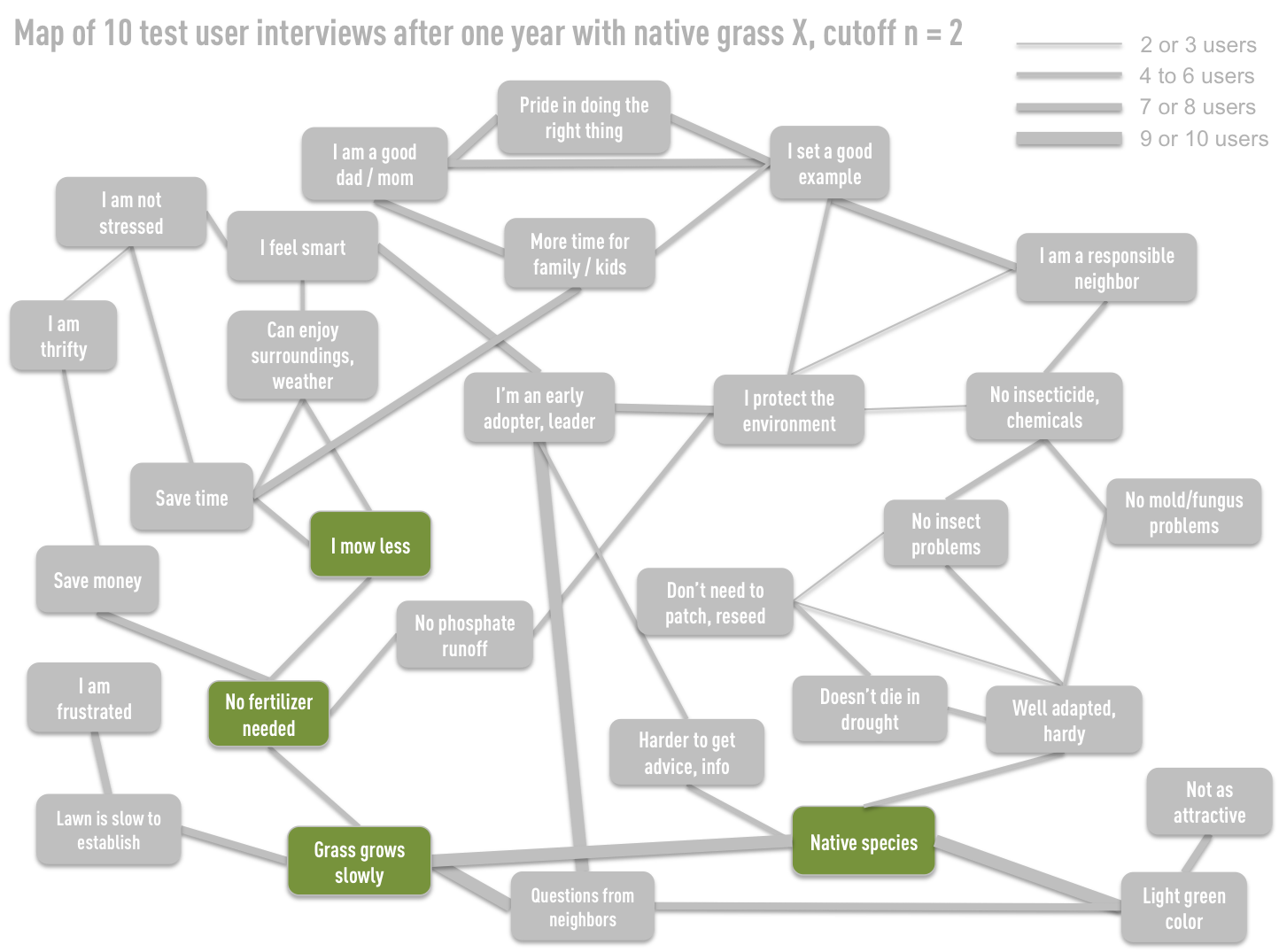
Here we see a subset of attributes from the image "Map of 10 test user interviews after one year with native grass X, cutoff n = 2."
The subset includes concepts centered around the following topics:
- Online calculator to calculate time and financial savings from converting an existing lawn to native seed
- Take the concept path with the highest current use/potential/traffic, and see if it can capture some percentage of revenue
and includes the following attributes:
- I mow less
- No fertilizer needed
- Grass grows slowly
- Native species
